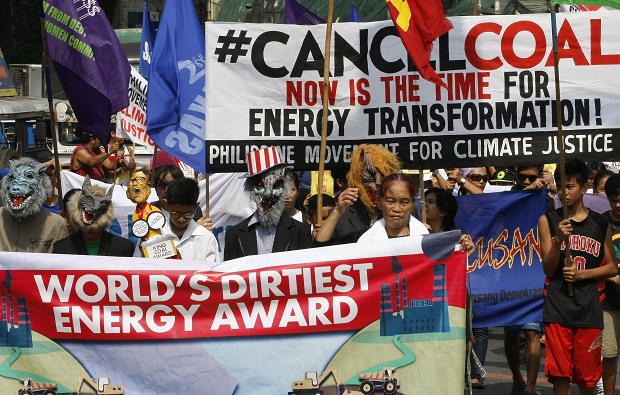UN report raises ceiling for greenhouse gas pollution

Protesters carry banners during a rally near the Presidential Palace to protest the country’s use of coal to power energy generation power plants which according to them has contributed to pollution Saturday, Oct. 10, 2015 in Manila, Philippines. The protesters are urging the Government to do more to reduce Greenhouse gas emissions which allegedly contributes to global climate change. AP
STOCKHOLM — The UN’s environmental authority has quietly raised its assessment of the level at which global greenhouse gas emissions must peak to avoid dangerous climate change, as governments seek a new accord to fight global warming.
In its first four annual emissions reports in 2010-2013, the United Nations Environment Program said emissions must not exceed 44 billion tons in 2020 for the world to limit global warming to 2 degrees C (3.6 degrees F).
But with real-world emissions rising far beyond that level, UNEP has since last year downplayed its focus on 2020 as a make-or-break year for emissions reductions.
In this year’s Emissions Gap report, a summary of which was released Friday, UNEP says the world can still reach the 2-degree target with emissions of 52 billion tons by 2020, which is just slightly below today’s level.
The new analysis assumes that emissions cuts will drop faster after 2030 than was assumed in previous reports.
Article continues after this advertisementUNEP chief scientist Jacqueline McGlade told The Associated Press the earlier assessments weren’t wrong, but were based on emissions scenarios that are “no longer realistic.”
Article continues after this advertisementCritics said the change reflects political pressure to show the 2-degree goal is still feasible as governments work on the U.N. climate agreement that’s supposed to be adopted in Paris next month.
“The emissions gap report gives the questionable impression that despite increasing emissions there’s always a way to reach the 2C target,” said Oliver Geden, of the German Institute for International and Security Affairs in Berlin.
READ: UN releases a draft for potential agreement on climate
The 2-degree target was adopted in UN climate talks in 2010. Two degrees of warming compared with pre-industrial times, is widely seen as a level where climate change becomes unmanageable, with fast-rising sea levels, intensifying droughts and other impacts.
Scientists say temperatures have already risen more than 0.8 degrees C (1.4 degrees F) since the industrial revolution, and that the warming is mostly man-made, mainly due to emissions from the burning of fossil fuels.
UNEP now places little emphasis on its earlier view that emissions must peak before 2020. Last year it just said emissions “need to peak soon” and this year’s summary didn’t even mention a peaking year.
Its scenarios assume the world will be able to remove more greenhouse gas from the atmosphere than what is added by human activity in the latter half of the century to make up for overshooting benchmarks earlier, which Geden called a “dubious” concept.
The idea of so-called “negative emissions” is that humans would plant more emissions-absorbing forests and crops, and deploy expensive technologies that capture emissions from the energy and industry sectors.
READ: 40-country survey: Majority support for cutting emissions
The UNEP reports are based on scientific assessments by the authoritative Intergovernmental Panel on Climate Change.
IPCC scientist Chris Field said that at some level questions of what peaking year or emissions reductions are feasible aren’t really about science.
“It is about the priority that the topic is assigned,” he said. “With a high enough priority, societies or even the world community can do amazing things. But amazing accomplishments require amazing efforts.”